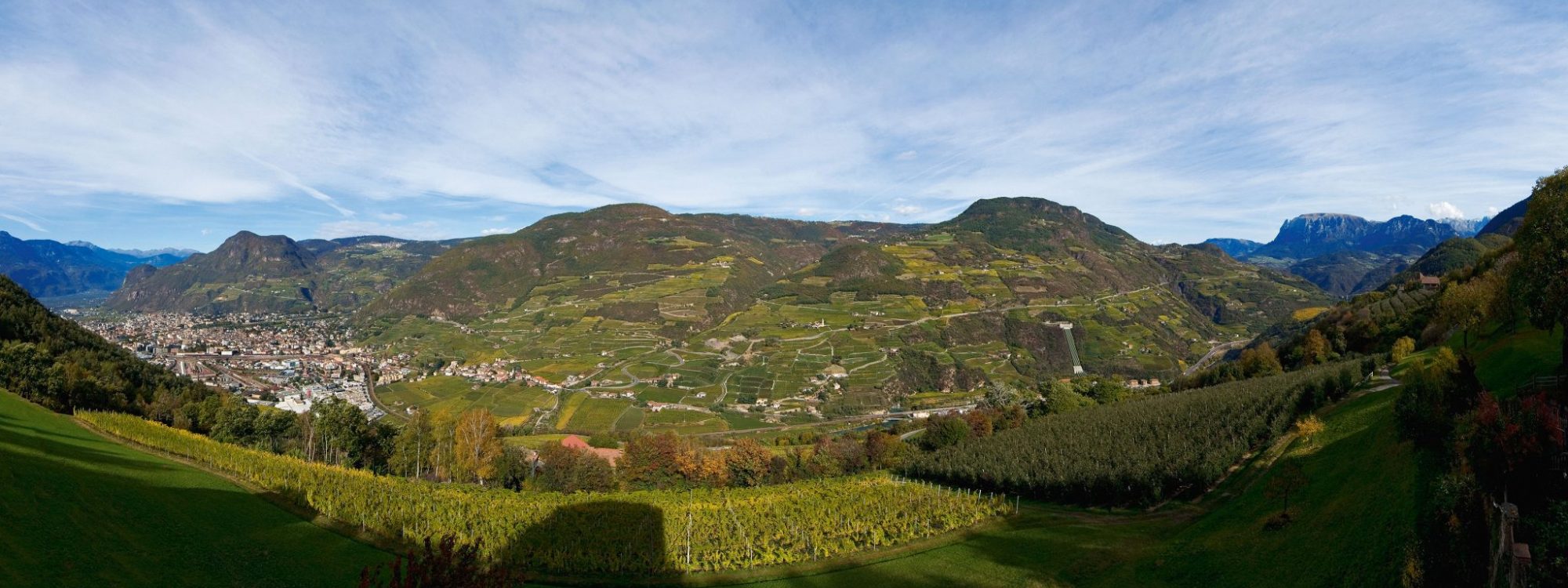The St. Magdalener from South Tyrol
A genuine product of Bozen
The vineyards on the hills and slopes overlooking Bozen are home to the St. Magdalener. There the Vernatsch grapes flourish and wait to be transformed into St. Magdalener. The classic area of cultivation for this quality wine comprises the hillside sites northeast of Bozen. They are some of the oldest and sunniest wine-growing sites in South Tyrol. The St. Magdalener grapes are cultivated on a total of 160 hectares, which is 3 % of the total wine-growing area of South Tyrol. The vines are trained on traditional pergolas, i.e. vertical posts linked with sloping wooden laths. Just as in the old days, they are characteristic of the landscape in the classic wine growing area of the St. Magdalener.
The grapes are used to produce about 1.6 million bottles of wine a year. Most of the wine growers – almost all of them family businesses – produce and market their St. Magdalener wines themselves.
Did you know?
A part of the St. Magdalener wines may call themselves classic
The St. Magdalener has a fresh, elegant and classic taste. If the St. Magdalener comes from one of the historical sites in St. Magdalena, St. Justina, St. Peter, Rentsch or Leitach, it is allowed to be called classico or classic . In 1971 this growing area was demarcated and the St. Magdalener was placed under legal protection of origin (D.O.C.).
The Vernatsch grapes that go into the St. Magdalener flourish on the hills and slopes northeast of Bozen. This elegant wine originated in the district of St. Magdalena, on a hill at the foot of the Ritten plateau, as well as the neighboring districts of St. Justina, Rentsch, Leitach and St. Peter.
Since the official demarcation of the area of cultivation, the Vernatsch grapes grown on other sites in the region may also be used to make St. Magdalener, e.g. Siebeneich, Moritzing, Guntschna, St. Georgen and Sand, Signat, Unterplatten, Karneid, Kardaun, Kampill, Kampenn, Virgl and Haslach.
The St. Magdalener is a master of adaptation. On high elevation sites, it does well on the loamy morainic soils of the last glaciation, whereas on the hills it benefits from the sandy alluvial gravel deposited in the last interglacial period. In Rentsch the vines grow happily on sandy-loamy soils produced by weathering of the quartz porphyry rock and along the River Eisack it flourishes on more recent alluvial deposits.
The Vernatsch grapes used to make the St. Magdalener love the temperate inner-alpine continental climate of the Bozen valley basin. With an annual total of 300 days of sunshine in South Tyrol, conditions are ideal for wine growing. The hot and dry days and pleasantly cool nights of summer and the relatively dry winters are the key to a harmonious combination of sugar concentrations and acidity in this elegant red wine.
The classic St. Magdalener area of cultivation

FAQs
St. Magdalener in brief
If it comes from one of the following districts: St. Magdalena, St. Justina, St. Peter, Rentsch or Leitach.
- It defines the area of origin of the wine.
- It means there are rules in place for permitted grape varieties and maximum yields.
- It stands for strict quality controls in the vineyard and cellar.

Elevation
between 250 and 500 meters above sea-level

Area of cultivation / yield
160 ha / approx. 12,000 hl

Oldest vine
approx. 80 years
History of the St. Magdalener
South Tyrol’s prized wines
The red Vernatsch (from the Latin “vernaculus” meaning “native”) is one of the oldest native red wine varieties in South Tyrol, where it has probably been cultivated since the 16th century. Even longer than that, for over two thousand years in fact, vines have been a characteristic feature of the landscape in the southern part of South Tyrol. Written records expressing praise for the wines of Bozen go all the way back to the Middle Ages. In those days, the wine estates largely belonged to South German monasteries and the nobility.
In the modern period, trade increased and the wine growers on their smallholdings also benefitted and became more and more independent. In those days the wines from today’s St. Magdalener area were considered “the most prized wines in Southern Tyrol”.
“For me the Consortium for the protection of St. Magdalener wine serves mainly to preserve the typicity of the St. Magdalener DOC, to monitor the quality and to promote and consolidate sales.”
Josephus Mayr from the Tenuta Erbhof Mayr-Unterganzner
Chairman of the Consortium for the protection of St. Magdalener wine
The Consortium
Protection for the St. Magdalener
Success creates a need for protection. St. Magdalener must be protected to ensure that it remains such an elegant, fruity wine and that it preserves its typical characteristics. In order to protect and promote this fine red wine, the wine growers of St. Magdalena decided back in 1923 – as the first wine growing commune in Italy – to establish a voluntary organization for the protection of the wine called the “St. Magdalener Weinbauerngenossenschaft” (St. Magdalena Wine-Growing Co-operative). Following the introduction of the DOC regulations for the St. Magdalener, the name was changed in 1978 to “Freiwilliges Konsortium für den Schutz der Weinproduktion von St. Magdalena” (Voluntary Consortium for the Protection of Wine Production in St. Magdalena). Since then, continuous measures have been taken to upgrade production and processing and increase public awareness for the St. Magdalener.
The St. Magdalener trademark
Strict controls
Production of the St. Magdalener DOC is subject to strict regulations: The wine must be made almost exclusively from Vernatsch grapes; only up to 15% share of other red quality grapes from the area of cultivation is permitted, with 5% Lagrein as a typical combination. Yield per hectare for the St. Magdalener is limited to 87.5 hl of wine produced according to a recognized process. The wine is only sold in 0.75 liter bottles and their multiple – a mark of quality.
It is the task of the consortium to check the quality of the trendy red wine from the production to the processing by an expert commission by controlling the St. Magdalener wines annually.

